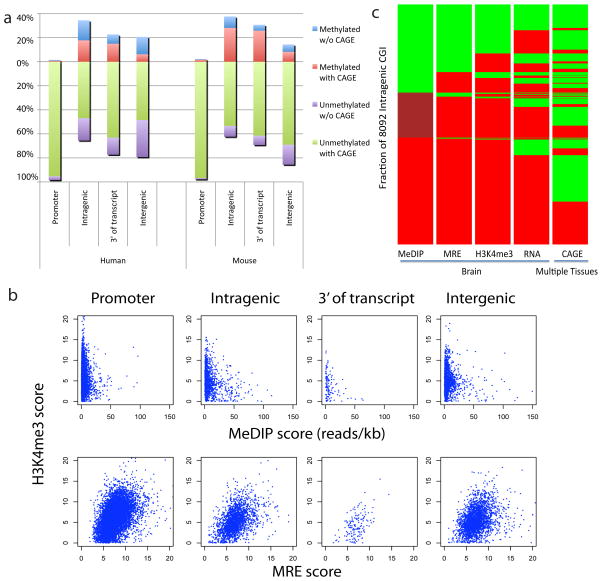Although it’s identified that the methylation of DNA in 5′ promoters suppresses gene expression, the role of DNA methylation in gene our bodies is unclear. In mammals, tissue- and cell type-specific methylation is current in a small proportion of 5′ CpG island (CGI) promoters, whereas a far better proportion happens throughout gene our bodies, coinciding with extremely conserved sequences.
Tissue-specific intragenic methylation may cut back, or, paradoxically, improve transcription elongation effectivity. Capped evaluation of gene expression (CAGE) experiments additionally point out that transcription generally initiates inside and between genes.
To examine the role of intragenic methylation, we generated a map of DNA methylation from the human mind encompassing 24.7 million of the 28 million CpG websites. From the dense, high-resolution protection of CpG islands, the bulk of methylated CpG islands have been proven to be in intragenic and intergenic areas, whereas lower than 3% of CpG islands in 5′ promoters have been methylated.
The CpG islands in all three places overlapped with RNA markers of transcription initiation, and unmethylated CpG islands additionally overlapped considerably with trimethylation of H3K4, a histone modification enriched at promoters.
The common and CpG-island-specific patterns of methylation are conserved in mouse tissues. An in-depth investigation of the human SHANK3 locus and its mouse homologue demonstrated that this tissue-specific DNA methylation regulates intragenic promoter exercise in vitro and in vivo.
These methylation-regulated, alternative transcripts are expressed in a tissue- and cell type-specific method, and are expressed differentially inside a single cell sort from distinct mind areas. These outcomes assist a serious role for intragenic methylation in regulating cell context-specific alternative promoters in gene our bodies.

DNA methylation age of human tissues and cell varieties.
BACKGROUNDIt just isn’t but identified whether or not DNA methylation ranges can be utilized to precisely predict age throughout a broad spectrum of human tissues and cell varieties, nor whether or not the ensuing age prediction is a biologically significant measure.RESULTSI developed a multi-tissue predictor of age that enables one to estimate the DNA methylation age of most tissues and cell varieties.
The predictor, which is freely out there, was developed utilizing 8,000 samples from 82 Illumina DNA methylation array datasets, encompassing 51 wholesome tissues and cell varieties.
I discovered that DNA methylation age has the next properties: first, it’s near zero for embryonic and induced pluripotent stem cells; second, it correlates with cell passage quantity; third, it provides rise to a extremely heritable measure of age acceleration; and, fourth, it’s relevant to chimpanzee tissues. Analysis of 6,000 most cancers samples from 32 datasets confirmed that each one of the thought-about 20 most cancers varieties exhibit vital age acceleration, with a median of 36 years.
Low age-acceleration of most cancers tissue is related to a excessive quantity of somatic mutations and TP53 mutations, whereas mutations in steroid receptors vastly speed up DNA methylation age in breast most cancers. Finally, I characterize the 353 CpG websites that collectively type an growing old clock in phrases of chromatin states and tissue variance.
CONCLUSIONSI suggest that DNA methylation age measures the cumulative impact of an epigenetic upkeep system. This novel epigenetic clock can be utilized to handle a number of questions in developmental biology, most cancers and growing old analysis.
